Three weeks ago we had a very confusing turtle visit our beach and decided that the odd crawl pattern likely indicated a turtle (probably a loggerhead) with an impaired flipper (see back story here). This has not stopped her from being successful as she laid eggs in Cape Hatteras National Seashore (more back story) and now (we think), again this morning in Kill Devil Hills!

The nest site for this turtle's crawl is atypical. Note the location of the eggs highlighted on the right.
Now all our NESTers would likely remind me that turtles typically visit in 2-week cycles and not 3-week cycles but this crawl is so unique, I really think that this is her return. Not only is the crawl so similar, but the weird nest sites she left are similar as well. Fortunately, DNA was collected at both successful nests and the results will confirm this story at which time we can boast for already knowing!
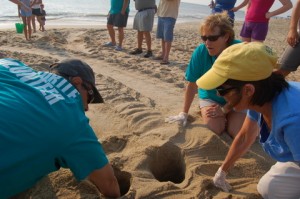
Barry feels the eggs, located between the first and second holes.
So taking our best guess on this unique nest site, NESTers began to dig for eggs. Barry’s first hole did not produce much success but almost immediately on his second, he felt the sand get soft and there they were! Right in line with the plastron drag but nowhere near the thrown sand pile.
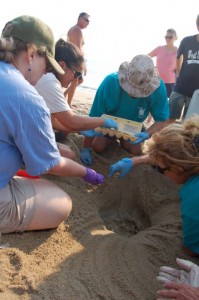
Patti, Elaine, Lia, and Dennis work the line.
Because the nest was located below the berm where this portion of beach often erodes during early fall storm activity, the nest was relocated to the foot of the dune. As volunteers began the egg train (removing eggs from the original nest site… Dennis of course being the caboose), others began digging a new chamber closer to the foot of the dunes. The new nest site would be dug to the same dimensions of the original nest site.
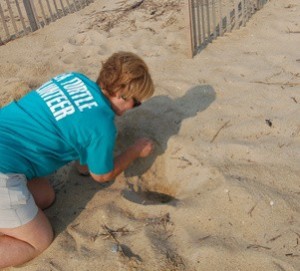
Jill starts digging the new nest chamber.
As the egg cartons kept filling, we began to wonder if we would have enough for all the eggs. Down to the last carton but they all fit! 108 eggs total.
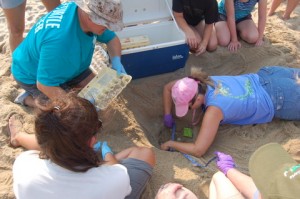
Stephanie measures the width of the "bowl" of the original nest site. The new site will replicate the same dimensions.
The new nest site was lined with sand from the original and then eggs were carefully placed back in, not be be seen for another two months.
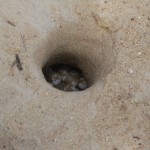
Eggs in their final resting spot.
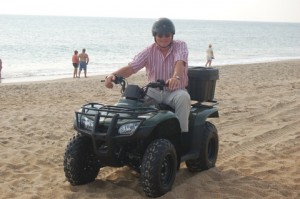
ATV rider George's first nest.
